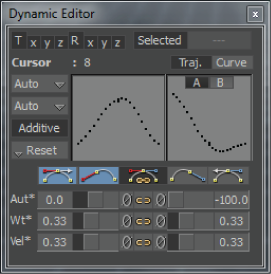When you set multiple keyframes for a property, MotionBuilder automatically interpolates the animation between the keyframes. You can see a graphical representation of this interpolation in the FCurves window.
To edit animation, you can create, view, and modify function curves in various ways. For example, you can control the type of interpolation between keyframes, the curve’s extrapolation, and the value and time of the function curve.
Each type of interpolation creates different animation. For example, a model animated along the Y axis with Auto interpolation would move up and down gradually, while the same model animated with Stepped interpolation would suddenly appear in different locations at each keyframe.
The list below explains the changes in terminology that have ocurred
The following figure shows the graphical representation of each interpolation type.

FCurves window A. Auto interpolation B. TCB interpolation C. Stepped interpolation D. Linear interpolation
You can set the type of interpolation before you set keyframes in the Key Controls window, or you can change the interpolation for keyframes using the FCurves window and the Dynamic Editor.
In the FCurves window, you can select keyframes and change their interpolation type, but you can also manipulate a function curve directly to alter the interpolation.
The slope of a function curve determines the speed at which the values change between keyframes. A steep slope means the value changes quickly, and a gradual slope means the value changes more slowly over a longer period of time.
While the FCurves window lets you modify the function curve of one selected keyframe at a time, the Dynamic Editor lets you simultaneously modify multiple function curves. You can edit the interpolation of selected keyframes or of keyframes at the current time.
The Dynamic Editor also lets you quickly alter the velocity of animation without changing its trajectory through space. It also lets you modify many function curves simultaneously. See Dynamic Editor.

Dynamic Editor